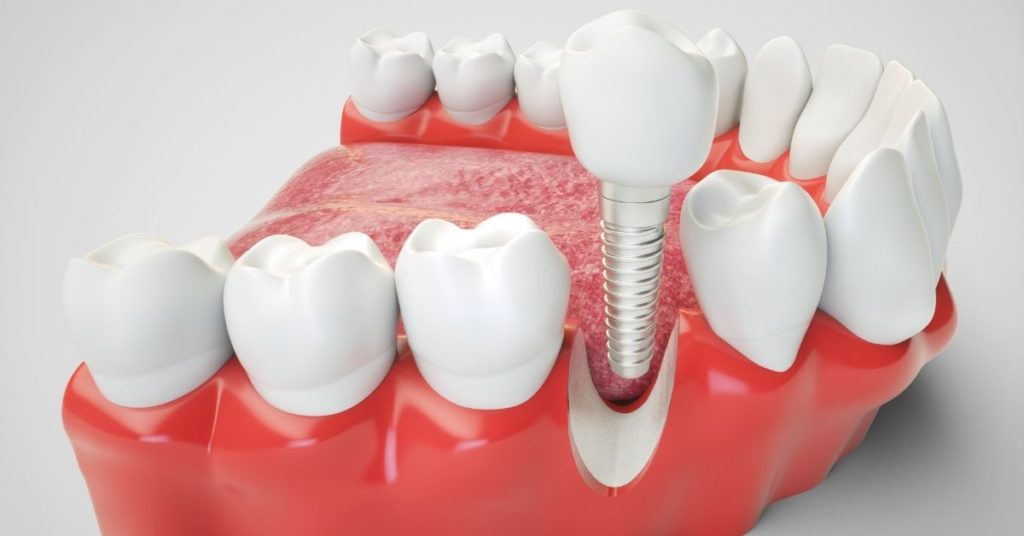- Dentistry Mosonmagyaróvár
Missing teeth caused by tooth extraction or trauma are not only often aesthetically unappealing and uncomfortable to the touch, but can also lead to more serious problems in the long term. Over time, tooth and bone loss can cause adjacent teeth to shift and collapse, damaging the periodontium, altering facial features, overstressing some teeth and the temporomandibular joint, and even causing voice and stomach problems. Dental implants, i.e. dentures with artificial tooth roots, are an excellent solution to eliminate all these problems and to ensure stable, aesthetic and permanent dentures.

A dental implant is a tooth-root-shaped threaded screw that is inserted into a previously made hole in the jawbone. It consists of a tissue-friendly, biocompatible material (usually pure titanium) so that it does not cause allergies and does not irritate the surrounding tissue. Once inserted, bone cells attach themselves to the surface of the implant, anchoring it to the bone as firmly as a natural tooth. As soon as the bone integration is complete, the visible part of the denture above the gums, i.e. the crown, bridge or even the entire denture, is placed on the implant.

It is essential for a successful dental implantation that the implant bed has healthy bone of sufficient size and density. If this is not the case due to a problem, the bone volume may need to be increased with special bone substitute materials or regenerative materials. It is also important that the oral cavity is free of foci and that the patient does not suffer from certain diseases, such as: B. severe cardiovascular disease, hematological disorders or unbalanced diabetes. Excessive alcohol consumption or heavy smoking are also exclusion criteria, as is being under the age of 18 if jaw bone growth is not yet complete.
Successful implantation requires a thorough assessment of the patient’s condition. Therefore, before the actual operation, a detailed medical history, X-rays and a CT scan are carried out. The main steps of the implantation planned on the basis of these results are as follows:
The sutures can be removed after a week, but it is not advisable to place the denture on the surface on the artificial root at this stage as it is not yet properly anchored in the jawbone. After a few months, the implant can be removed and the gum-forming and denture-stabilizing units can be attached, followed by the actual denture after a short time.
Dentures with dental implants are recommended for all patients who want to get rid of missing teeth in an aesthetic, comfortable and permanent way, without grinding down the neighboring teeth, and for whom there are no reasons against implantation. Patients with certain serious medical conditions, excessive substance abuse (e.g. heavy smokers), lack of bone structure at the planned implant site or under the age of 18 are excluded.
The placement of the implant itself in the jawbone can be done quickly, but the entire implantation and restoration process – including thorough pre-operative examinations, healing, ossification, shaping of the gums, preparation of the restoration after impression taking – takes a lot of time and requires multiple sessions. On average, it takes 4-6 months to replace a missing tooth with an implant. However, this period can be extended by several months if bone augmentation is required or if there are circumstances that make healing difficult. The process should not be rushed as an implant loaded too soon will lose its durability!
The dental implant is prepared and inserted under anesthesia, so there is no pain. There may be some pain and swelling after the procedure, but this is temporary.
When properly placed, antiallergic dental implants can function for many decades, but very rarely, less than 1-2% of cases, they can be expelled. The most common causes of late expulsion are poor oral hygiene and smoking, which can contribute to the development of bone-wasting inflammation. In addition to the loosening and mobility of the implant, expulsion can also be indicated by pain, swelling or bleeding.
Like your own teeth, implanted teeth also need thorough and regular cleaning, otherwise plaque and tartar build up on the dentures and the pathogens they contain can lead to inflammation, periodontal diseases and, over time, loosening of the implant. In addition to the mandatory annual check-ups for implants, it is therefore worth visiting your dentist regularly for professional oral hygiene treatments. In addition, dental floss and other special dental cleaning equipment are recommended as part of your at-home oral care routine.

Fill out the form, click the login button, and we will contact you soon.
Dr. Bekő Gabriella
Implanmed © 2022. All rights reserved!